The Amish of Enon Valley, PA (14 Photos)
You might recall this image from the 5 Mystery Photos post:
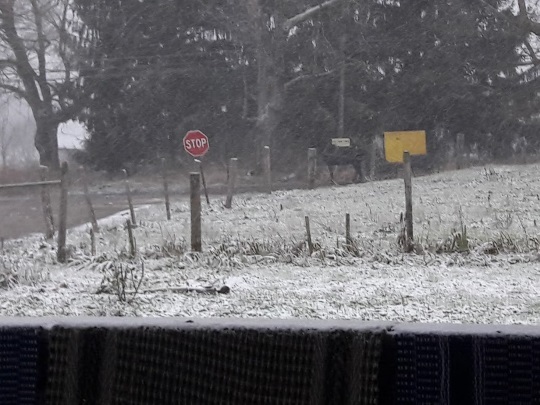
I explained in the follow-up that this unusual buggy was from the settlement at Enon Valley, Pennsylvania.
I had been wanting to visit this settlement for some time and had a chance to do so in early December, but due to time constraints, weather and darkness it wasn’t quite what I had hoped it to be – more of a drive-through visit.
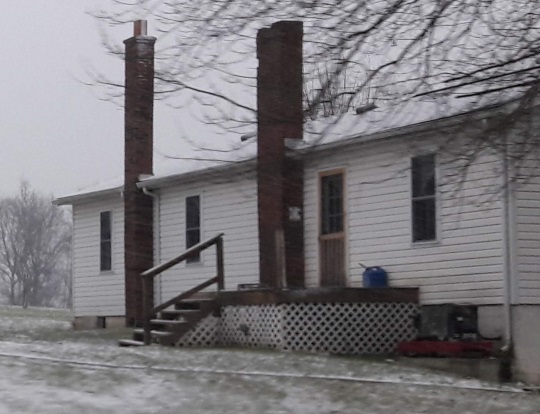
So I don’t have as much info to share as is the norm, and neither are these photos going to be of stunning quality. But you should get a bit of a feel for my visit and a glimpse of the settlement at least.
I drove over from Holmes County with snow coming down most of the two-hour journey. By the time I arrived dusk was approaching.
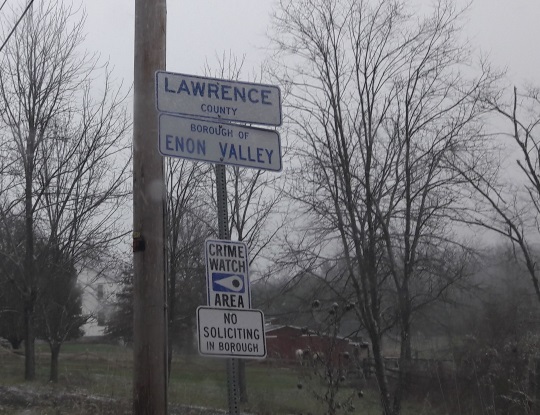
When in a new Amish area, business-signs are tell-tale indicators of Amish in the area. You can usually tell by the look – often hand-lettered – or the business names themselves (Amish are fond of using initials, or their easily-recognizable last names to identify their shops and stores).
Here’s a greenhouse sign, which looks suspiciously Amish. But is it? I don’t think so, as I came across a greenhouse which was clearly English-owned in that general direction.

What makes the Enon Valley Amish settlement unusual?
Enon Valley is an unusual community for several reasons:
1. Buggy Color
The most obvious aspect is the buggy top color. As mentioned it’s not exactly the yellow of the Byler Amish of Big Valley nor is it the brown of nearby New Wilmington. To me it seemed more of a muddy yellow.
Another aspect of buggy color is mentioned in an Amishman’s writings in the 2003 edition of the New Wilmington church directory:
“The Amish in Enon Valley, PA still have their carriage box and gears kind of brown color, not black.”
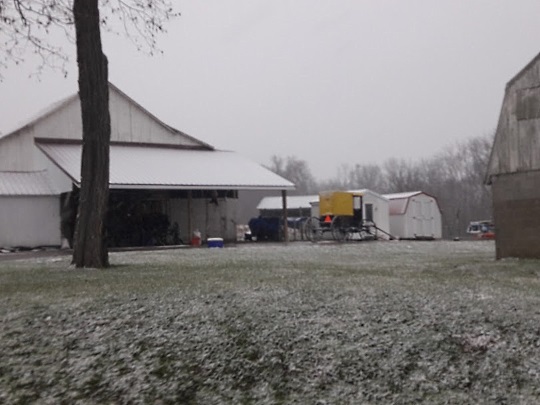
2. Age & Size
The Enon Valley Amish community is 100 years old this year, but just one church district in size. Sometimes you see this – old communities that for whatever reason are a much smaller size than you might expect them to be (other examples include Oakland, Maryland, founded in 1850 and just one, albeit large, church district, and Kokomo, Indiana, founded in 1848 and just two churches in size).
Given Amish growth rates, settlements commonly expand over time. But some communities have complicated histories and may grow then shrink or never really grow much to begin with.

3. Other factors
An Amish person quite familiar with the community shared with me a few other things, some of which shed light on the above. He said it was something like a fusion of the Nebraska Amish and the New Wilmington Amish (I am assuming he meant Ordnung).
He also described it as a “stepping-stone” settlement to higher churches, noting that if that were not the case, it would be very large, while currently he guessed it has only about 15 households.
He also said that for some time they even had brown wheels on their carriages, creating an unusual look, though black was accepted now.
And as far as that goes, though I had the help of Raber’s Almanac, it was a bit hard to find many Amish homes here.
The growing darkness and accumulating snow also made it difficult for me to find businesses or Amish people to talk to.
Here’s a buggy warning sign near the bishop’s farm:
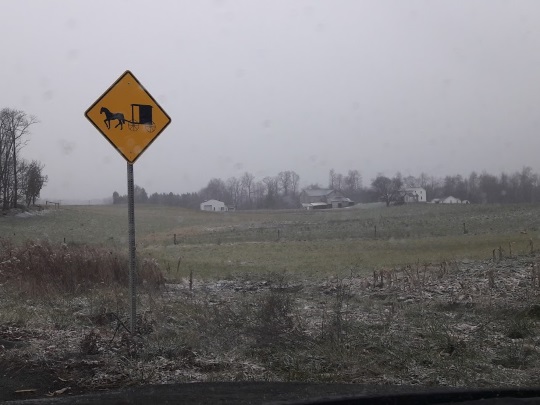
I did speak with one Amish woman and asked if there was a local store, a bulk food or variety store I could visit. She suggested one to me which I believe was actually in the New Wilmington community about a 20-30 minute drive north. So that suggested that there are not a lot of businesses here and truth be told it was hard to find many Amish homes, though I did spot at least one school.
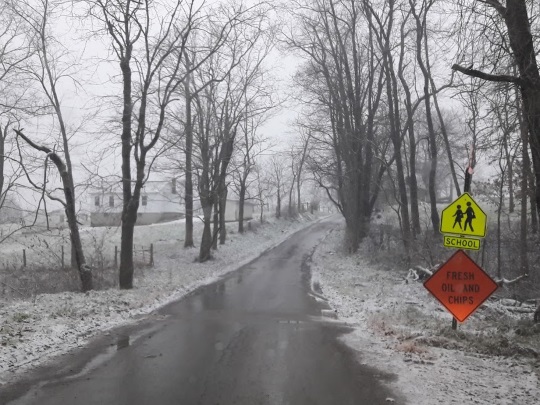

Here’s another buggy. It might have been the light but this one seemed to me to have more of a pure yellow tone compared to the others:
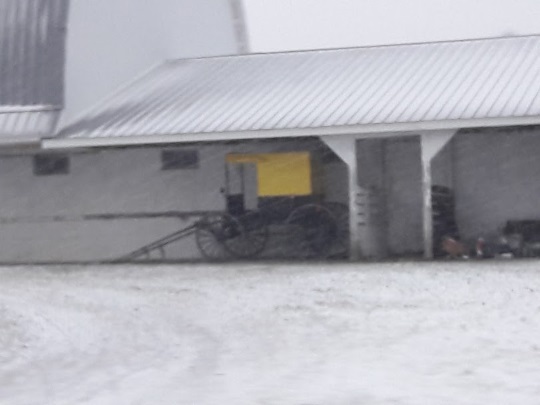
Blue door (also common to both the Nebraska Amish and New Wilmington Amish):
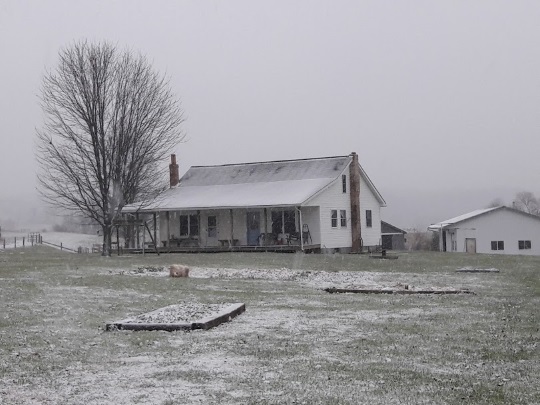
I also went by what at one time was apparently a minister’s home, and found a vacant place which looked at one time rather Amish but now clearly was up for sale.
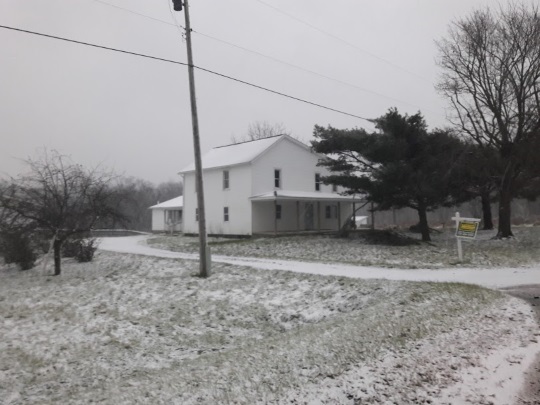
Here’s where the mailbox once must have hung on the opposite side of the road:
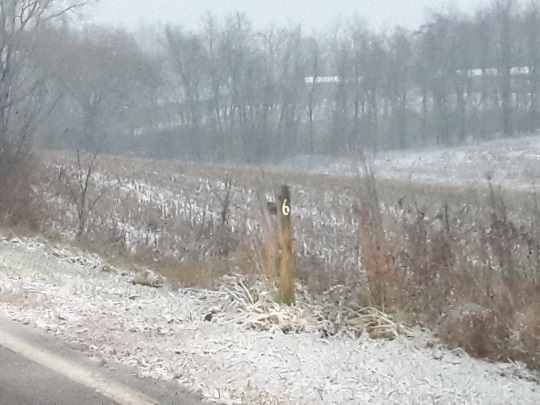
And a view from the other side, with buildings in the back:
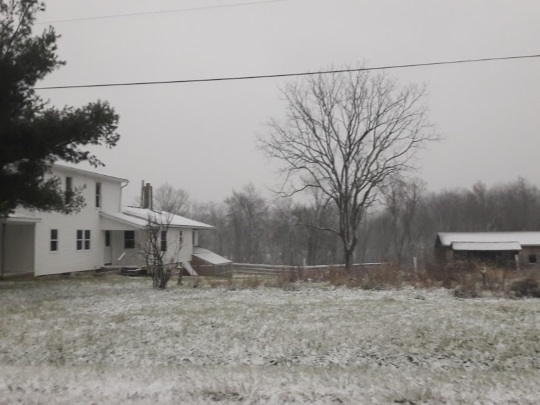
That’s about it for my visit. I’d like to return in the warmer months and spend a bit more time there. I spotted just one Amish business (storage buildings) but I would bet there are at least a couple others. It would also be interesting to learn more about the history of this atypical community.





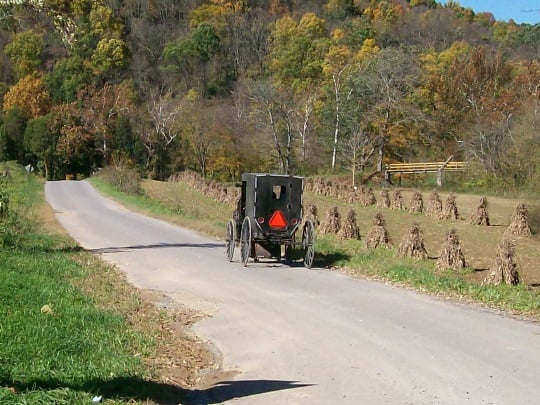
Thank you for your research and excellent photos. I sure do appreciate the journeys you make.. Troy
Thank you for your research and excellent photos. I sure do appreciate the journeys you make. Troy Parks
Thanks Troy, I hope to share more with you as we get further into 2019!
Enon Valley
Looks and feels like a community that might still be close to failing – it is a common understanding that you can’t stand still – you either increase or decrease. If all of the growth continues to move away, there would seem to be little hope to continue many years even if if the community is 95 years old.
That’s right Osiah. One of my favorite books on the Amish continues to be David Luthy’s Settlements That Failed. Very well-researched and detailed accounts of settlements that came and went, some which were around for just a short while, some which lasted decades before dwindling and disappearing. This might be the case with Enon Valley, hopefully not but if so that’s just the way of things.
After posting I recalled I visited another one in a similar situation at Hicksville, OH, 10 years older than Enon Valley but also just one church in size: https://amishamerica.com/hicksville-ohio-amish-community/
The DIVINE GRACE
Dusk or Dreary doesnt diminish the Amish beauty of Life.
Color of buggy top
I wonder if yellow was chosen for buggy tops for safety reasons like the road signs and school buses. A possibility especially if there is a lot of motor vehicle traffic in the area.
Mary if you didn’t see it, check out Yoder in Ohio’s answer below. I was going to try to reply to you but wasn’t sure I had my facts straight, but Yoder is up to speed on this buggy history 🙂
Interesting
Very interesting these small communities are. I was wondering if they are kind of like the path Valley Amish of path Valley Pennsylvania. They’re in the dry run Willow Hill area. Very small community extremely conservative just don’t know much about these types.
Jason I recall the Path Valley community from a Washington Post story about farmers’ co-op supplying DC restaurants (and of course they were also in the news following a fire a couple of weeks ago). The story mentioned they use an icehouse to cool produce, and icehouses are usually a lower or plainer Amish characteristic…I didn’t get a great sense of how things go as far as Ordnung in Enon Valley, though I can mention one odd detail, one of the homes had a portable toilet parked right outside the side door of the house. Not sure if it was there temporarily for some reason but might mean that this group uses the outhouse (or in this case port-a-potty) rather than conventional plumbing.
https://www.washingtonpost.com/lifestyle/food/how-a-small-amish-farm-co-op-came-to-supply-dcs-top-restaurants/2017/06/02/65e746e8-419a-11e7-adba-394ee67a7582_story.html?utm_term=.2d1bb10f698d
https://amishamerica.com/5-ways-an-amish-farm-co-op-supplies-50-top-d-c-restaurants/
And as the person-in-the-know I mentioned in the post told me, the EV Amish are considered something of a fusion of the Nebraska Amish and New Wilmington Amish, both considered to be on the plainer end of things.
Erik, a porta-potty might be rented for an event — church or whatever — to make sure there are enough “facilities” for everyone.
Ahh, right. It just seemed to be in quite an odd place for a “permanent” one. I checked the other photos and didn’t see any church signs like a wagon, but I bet you’re right. Thx!
Does Enon Valley have a church-wagon? I’m not sure… ??? The more conservative groups, like the Nebraskas, and Swartzentrubers, don’t have them.
So I just learned something. Maybe I should have known this but I hadn’t realized those plainer groups don’t have them. So are they hauling benches using some sort of flatbed wagon?
In some groups the wagons might be hauled on a flat bed wagon or stacked in a “box wagon.” Then in some groups, such as the Nebraska Amish, it’s still common for each family to own their own benches, songbooks, dishes, etc. that are needed for hosting church.
Benches
The Amish in Enon Valley all have some benches at their homes for church. When their is a larger gathering, they gather them all and bring them. They are considered Old Order Amish. They use outhouses and the only indoor plumbing would be in the kitchen with an old fashioned hand pump. They are now allowed telephones out by the road. They use porta potties for larger events, not church. It is a small community here. They are a mix of New Wilmington and Schwartzentruber. They are slowly allowing more things as the younger generations are growing up. My husband grew up in this community, we still live in Enon Valley. We still keep in contact with his Amish family members here.
Enon Valley Amish
I am just getting acquainted with the Amish in Enon Valley after being back in the area for over 20 years! I live near New Wilmington and have tons of photos and information on them, but just started exploring Enon Valley this past year and was able to get photos twice this past year. Their buggies are a brighter yellow, especially compared to New Wilmington’s burnt orange. Not as bright as Byler Amish in Big Valley, however – in my opinion. A friend of mine had a photo of the older buggies from the 1980s that had the brown bottoms – we posted them on Amish All the Way Facebook group, and I also posted my photos in that group. I had one photo from the Benefit Auction last year that had an Enon Valley buggy next to New Wilmington buggies and you can really see the contrast. I am so glad that you got some of the history of the Enon Valley group! Hope you get to come back to the area in good weather, it is a beautiful valley. They have a great Historical Society if you want more background on the area.
DM, thanks for sharing as another local voice. Would love to see those photos you mention, I’ll try to hunt them down on FB. I haven’t ever really seen very clear shots of EV buggies and didn’t really get any up-close ones. I’d especially like to see the photo you mention paired with the NW buggy. Would just need to add a Byler buggy somehow to that shot and then we’d have the full comparison 🙂
Enon Valley Amish
Erik if you have a hard time finding the photos, I’d be glad to email them to you if you’ll give me an address.
DM, this is a year and a half later, and I realized I don’t think I ever gave you an address. If you happen to see this and would like to share those photos, I’d be glad to see them: ewesner[at]gmail[dot]com
I happen to be prepping another post on the settlement today, which is why I came across this.
Winter
There is a sense of dreary in these winter photos for many, but not me! I think it’s fond memories thought that have me looking at these pictures differently.
There’s a sense of desolation and even failure in a depressed area, that does show throughout in your pictures, Erick. Some of these photos reminded me of towns in upstate New York for sure! Soap on the windows, boards on the windows, stores and homes badly in need of paint and maintenance, are common sights here.
Many Amish took over deserted farms, but almost a decade later while the fields are plowed, many towns and neighborhoods have continued to decline. Moreover, there’s been several Amish families that needed to return to their roots juts this fall – some dragging their feet, others eager to leave.
In the dozen years of living both upstate New York and Long Island, this is the first year I reluctantly returned upstate for work! I see central New York, the Leather Stocking Region, Western New York, and the Adirondacks all continuing to struggle. People in general; Amish not withstanding, are leaving! I
I agree with you Maureen, the “dreary” winter photos have their own appeal…though living in dreary conditions has less appeal, but I think I still prefer it to oppressive heat…and I grew up in a fairly hot and sunny place 🙂
I am sure some Amish who have moved to NY have decided it is not for them. Generally the trend is significant Amish growth in the state, however. The Amish can potentially add something to local economies but I guess “upstate New York” is a pretty large region and the Amish population which has grown to around 20,000 in NY is a relative drop in the bucket. Still, I think they have to be having some positive economic impact in many of the places they’ve settled.
I have only been once to a New York Amish community – last month to the Morris, NY settlement mentioned here a few blog posts ago. It happened to be quite a dreary day, the dreariest of my week-long trip, but we had a hot lunch waiting of venison stew and of course good conversation while catching up with an old friend, which made the visit that much better 🙂
Amish in the Champlain Valley
Maureen could well be correct in asserting that there is lots of outmigration from the Adirondacks of New York state. But that doesn’t mean that there are no contrary cases!!! The northern New York Amish keep moving closer to the Lake Champlain. My relatives see not a few Amish patients at the hospital in Plattsburgh. One of my sisters even reported talking to Amish at Walmart in Plattsburgh.
The Heuvelton Swartzentrubers have established a settlement around Westport and Lewis, New York. It does not appear to be growing very rapidly.
Further south, the Amish settlement near Whitehall NY, was reported in Amish America to include 17 farms–even though it was established only within the last ten years or so.
I myself am a returnee to Port Henry NY, near the lower Champlain bridge. And I have a cousin, a retired administrator from Harvard University, who came home to live in retirement and has established a business in the village.
There is abundant unused farmland in the lower Champlain Valley on the New York side and plenty of room for new Amish settlements.
Amish even closer than you think?
Right, the general trend has been in-migration and above-average Amish growth in NY state. Certainly some areas are not going to thrive as others do, and Amish settlements do fail to take off or just fail outright (there have been many dozens if not hundreds throughout history). So I’m not surprised to hear from Maureen of several families that had to leave the area.
Interesting to hear about your region. I had a closer look, and there hadn’t been a lot of Amish settlement near you in NY, at least not up until 2013 – it’s been more in the central and western parts of the state, and along the Canadian border. I wonder why, especially if there is abundant unused farmland in your area. Maybe it’s just a matter of time, especially with Whitehall as well as what you’ve started to see in Plattsburgh.
I did just check the latest Raber’s Almanac, and there is in fact a community listed in Essex County near the town of Essex, which looks like it would be a good bit closer to you in Port Henry than even Whitehall. However I would guess that it is a pretty small settlement as there is only one minister listed. Interestingly, though it’s an Essex address, the church district itself is called Westport, and I see that is the name of a village or town that’s even closer to Port Henry.
Amish of Enon Valley
It has been many years since I have been back to that area. Warmer weather is really the best time to visit when the Amish are out and about. I don’t know if it is still there but there used to be a big auction barn across from the cheese factory, where some of the Amish ladies would set up with baked goods,homemade noodles,jams and jellies and more. The flea market was before the auction every Tuesday. When I was selling at the flea market I got to know a Mrs Raber and bought eggs from her. I know that those folks used to be able to shop in Darlington, but I think that store has closed. There is a Historical Society that you might be able to find a lot of info. I now live in Ohio about an hour from Holmes county so if you are going in to PA again leave early in the morning and give yourself time for the drive. Thank you for this news letter and your travels.
Thanks Ruth for this comment from someone who knows the area. So, I totally missed the cheese factory! And definitely the auction barn as well, if that is still there. Will have to look out for that when I’m back in better weather. I do think I drove past the historical society though, right at the main intersection in Enon Valley. So that’s a couple of stops to make next time.
Amish of Enon Valley
I just read Heather Hostetler’s comment. I haven’t been to that area for a few years so I didn’t know the auction barn isn’t in operation anymore. That is a shame because they did a booming business every Tuesday. I know people who used to stock up on the Swiss cheese from the cheese factory and take it back to Texas to distribute to friends, neighbors and family. Thank you for taking an interest in the Amish of Enon Valley. Try to visit the Historic Society the next time you are in that area.
The auction barn is not in operation any longer. The cheese plant sells cheese but hasn’t made cheese in a good number of years. Both Mr. and Mrs. Busser have passed and the kids have the properties now. This isn’t a depressed area even for the Amish so much as inner turmoil amongst the local Amish have caused a lot of them to move to other communities. It never was a large settlement. There are Amish businesses but they don’t advertise for the most part. Most of them are either bakeries or builders in Enon. You can find their baked goods at all of the local stores and they also sell them at flea markets and auctions. There was a bulk/seconds store that is Amish run directly across the street from where the author spoke to the Bishop. They are only open a day or two a week. And the color of the buggies are a school bus yellow.
Great post!
The yellowish color was not for traffic safety, though it seems that way. It’s an old custom. Earliest Amish carriages were covered with white canvas-like stuff that was not waterproof. Some started coating the material with linseed oil to make it more water-proof and that gave a pale yellow color. Then some, like the Byler Amish in Big Valley started using raincoat material, with was rubberized & yellow. Eventually the color became tradition even after vinyl material came into use.
Thanks Yoder, I remember reading about the linseed oil/raincoat material explanation but was pretty sure I’d get the details wrong somehow. Interesting how that came about and I still find it amusing that such a bright and bold color is used by this group of Amish while on the other hand there are Amish folks who object to the relatively small orange triangle for its gaudiness. Yet another example of variety within the Amish. Though I suppose the original point was not to attract attention but a more practical reason as you note, and then the color eventually became baked into the cake of tradition, so to speak 🙂
Ha! I liked your “baked into the cake” comment, Erik! Yes, the bright yellow does seem odd when you think about others having issues with the SMV, but it all comes down to what you are used to. If you grow up around yellow buggies, that is the “norm.” If you grow up around no SMV signs on buggies, that is the “norm.” And since both types of groups don’t often cross each other’s paths, each goes their own way thinking their way is the best AND normal way.
Good point about “the norm” Yoder. But the “best” way or just “our” way? Or maybe those attitudes are stronger in some places than others..
But isn’t “our” way usually the “best” way? 🙂 Seriously, that’s how a lot of people see it.
I’d agree and have definitely gotten that vibe before…but pertaining to Amish people I can also say I’ve felt very “non-judged” for my different way of life, church, etc. Maybe it’s more an intra-Amish mindset (or just generally more common when you have a larger group comprised of smaller related groups but having secondary differences between them).
Blue Door
As far as the Blue Door which is common to the Nebraska and Wilmington Amish I have been wondering why it’s painted blue. Some years ago I came across a book of old Dutch farm houses. many of these had blue doors and window sills painted blue.
There was an explanation as to why paint blue paint was used. The reason is to repel flies!
No doubt the Amish do it for the same reason.
Blue painted doors to repel insects?
I think I’ve read that explanation somewhere George, thanks for bringing it back to my attention. I would be interested in confirming that but I wouldn’t be surprised if that’s how the custom developed. There are a lot of results suggesting blue does drive off insects if you Google the topic, but here is one that caught my eye, giving some potentially scientific explanation for the belief:
https://www.sherwin-williams.com/architects-specifiers-designers/inspiration/styles-and-techniques/sw-article-pro-thewhysbehind
Blue Paint as Insect Repellent?
Some people swear that blue paint repels insects, leaving a porch bug-free and pleasant during those long summer evenings and afternoons. Most credible sources discredit this belief. However, this belief could be seated in historical truths.
When blue paints were first used on ceilings, they were usually milk paints, and those paints often had lye mixed into the composition. Lye is a known insect repellent, which would explain why insects would avoid nesting on a painted porch ceiling or ledge. As milk paint has a tendency to fade over time, giving it a rustic look, people would usually need to repaint their home every year or few years, covering the existing coat with a new coat of paint, and fresh lye.
Pictures.
Very pretty photos, I love winter scenes.
Thanks so much for posting them.
Glad you thought so, Debra – will have some more photos up soon, from Holmes County, OH.
Unaffiliated?
I was rereading a bit of Donald Kraybill’s book on the 2011 beard cutting attacks by the Bergholz renegades in Ohio and discovered Enon Valley had ties to Sam Mullet’s renegade group at Bergholz back in the late 1990’s and early 2000’s. When Sam Mullet started the Bergholz community, he turned to the bishop in Salinesvill, Ohio, a man who “soon moved to Enon Valley, a small unaffiliated Gmay in western Pennsylvannia.” (“Renegade Amish”, p. 27). The Enon Valley bishop was the one who ordained Mullet, but cut ties with him and the Bergholz group in 2008. The Enon Valley bishop was described on page 27 as a “lone ranger leader who had no ties to other Amish groups beyond his own congregation.” I was wondering if the Enon Valley community is still unaffiliated at this time. Due to the time lapse, a new bishop could well be in charge. It seems implied in Kraybill’s book that Enon Valley is very conservative, something confirmed here. Thanks for the posts, Mr. Wesner.